改一般疑问句及否定句
小学英语句型转换之肯定句改否定句、一般疑问句
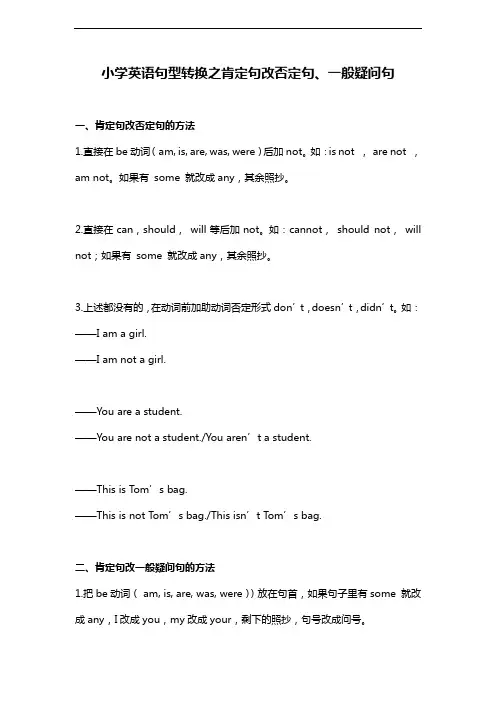
小学英语句型转换之肯定句改否定句、一般疑问句一、肯定句改否定句的方法1.直接在be动词(am, is, are, was, were)后加not。
如:is not ,are not ,am not。
如果有some 就改成any,其余照抄。
2.直接在can,should,will等后加not。
如:cannot,should not,will not;如果有some 就改成any,其余照抄。
3.上述都没有的,在动词前加助动词否定形式don’t,doesn’t,didn’t。
如:——I am a girl.——I am not a girl.——You are a student.——You are not a student./You aren’t a student.——This is Tom’s bag.——This is not Tom’s bag./This isn’t T om’s bag.二、肯定句改一般疑问句的方法1.把be动词( am, is, are, was, were))放在句首,如果句子里有some 就改成any,I改成you,my改成your,剩下的照抄,句号改成问号。
2.把can,shall,will,would,should ,could,may ,must等放到句首,如果句子里有some 就改成any,I就改成you,my就改成your,剩下的照抄,句号改成问号。
3.上述都没有的,就在句首加助动词Do,Does,Did帮忙,如果句子里有some 就改成any,I就改成you,my就改成your,剩下的照抄,句号改成问号。
4.注意:句首的第一个字母要大写,句尾标点应为“?”。
变一般疑问句时,肯定句是I am …,就把I am …变成Are you …?变一般疑问句时,肯定句I was …,就把I was …变成Were you …?如:——I am in Class 6.——Are you in Class 6?——You are from America.——Are you from America?——It is an orange.——Is it an orange?5.就一般疑问句回答一般疑问句有两种回答,即:肯定回答和否定回答。
陈述句变成一般疑问句和否定句
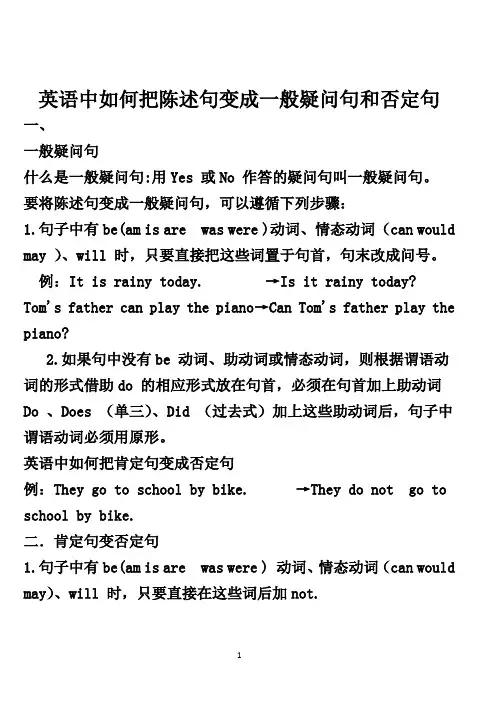
英语中如何把陈述句变成一般疑问句和否定句一、一般疑问句什么是一般疑问句:用Yes 或No 作答的疑问句叫一般疑问句。
要将陈述句变成一般疑问句,可以遵循下列步骤:1.句子中有be(am is are was were )动词、情态动词(can would may )、will 时,只要直接把这些词置于句首,句末改成问号。
例:It is rainy today. →Is it rainy today?Tom's father can play the piano→Can Tom's father play the piano?2.如果句中没有be 动词、助动词或情态动词,则根据谓语动词的形式借助do 的相应形式放在句首,必须在句首加上助动词Do 、Does (单三)、Did (过去式)加上这些助动词后,句子中谓语动词必须用原形。
英语中如何把肯定句变成否定句例:They go to school by bike. →They do not go to school by bike.二.肯定句变否定句1.句子中有be(am is are was were ) 动词、情态动词(can would may)、will 时,只要直接在这些词后加not.例:It is rainy today. →It is not rainy today.Tom's father can play the piano →Tom's father can not play the piano .2. 谓语动词是行为动词时,必须在动词前加上动don’t 、doesn’t(单数第三人称)didn’t(过去式), 句子中谓语动词用原形。
例:They go to school by bike. →They don’t go to school by bike.注意:1.在把肯定句改成否定句或一般疑问句的时候, 要注意句thing 、somebody 等词,如果有也必须进行改变,already 要改成yet ,some 、something 、somebody 等分别改成any 、anything 、anybody 等。
陈述句变一般疑问句和肯定句变否定句的几点技巧
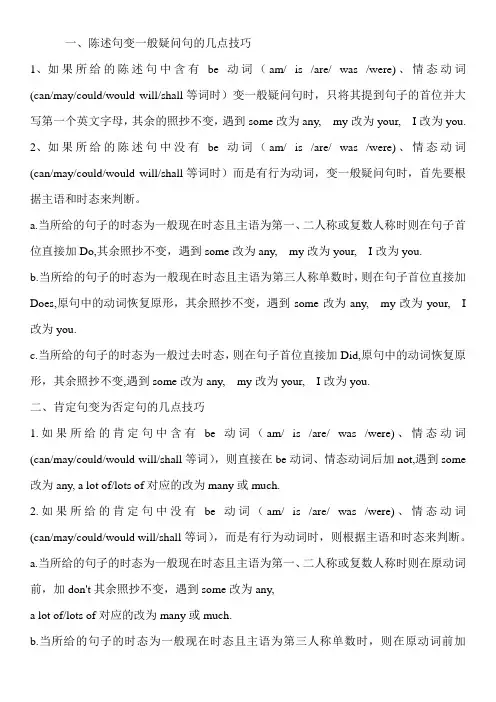
一、陈述句变一般疑问句的几点技巧1、如果所给的陈述句中含有be动词(am/ is /are/ was /were)、情态动词(can/may/could/would will/shall等词时)变一般疑问句时,只将其提到句子的首位并大写第一个英文字母,其余的照抄不变,遇到some改为any, my改为your, I改为you.2、如果所给的陈述句中没有be动词(am/ is /are/ was /were)、情态动词(can/may/could/would will/shall等词时)而是有行为动词,变一般疑问句时,首先要根据主语和时态来判断。
a.当所给的句子的时态为一般现在时态且主语为第一、二人称或复数人称时则在句子首位直接加Do,其余照抄不变,遇到some改为any, my改为your, I改为you.b.当所给的句子的时态为一般现在时态且主语为第三人称单数时,则在句子首位直接加Does,原句中的动词恢复原形,其余照抄不变,遇到some改为any, my改为your, I 改为you.c.当所给的句子的时态为一般过去时态,则在句子首位直接加Did,原句中的动词恢复原形,其余照抄不变,遇到some改为any, my改为your, I改为you.二、肯定句变为否定句的几点技巧1.如果所给的肯定句中含有be动词(am/ is /are/ was /were)、情态动词(can/may/could/would will/shall等词),则直接在be动词、情态动词后加not,遇到some 改为any, a lot of/lots of对应的改为many或much.2.如果所给的肯定句中没有be动词(am/ is /are/ was /were)、情态动词(can/may/could/would will/shall等词),而是有行为动词时,则根据主语和时态来判断。
a.当所给的句子的时态为一般现在时态且主语为第一、二人称或复数人称时则在原动词前,加don't其余照抄不变,遇到some改为any,a lot of/lots of对应的改为many或much.b.当所给的句子的时态为一般现在时态且主语为第三人称单数时,则在原动词前加doesn't原句中的动词恢复原形,其余照抄不变,遇到some改为any,a lot of/lots of对应的改为many或much.c.当所给的句子的时态为一般过去时态,则在原动词前加didn't原句中的动词恢复原形,其余照抄不变,遇到some改为any,a lot of/lots of对应的改为many或much.将下列句子变为一般疑问句和否定句1. His father is an English teacher.2. These cats are crying.3. They can swim.4. I like to read English.5. I go to school on foot.6. He likes English.7. His father goes to work by bus.8. He is crying under the tree.9. His birthday is on the twentieth of November.10. Mrs. Li and Kitty are in a big shop.11. Kitty is wearing her new uniform.12. The boy under the tree is hungry.13. He goes to school every day.14. I want to have a model car.15.She wants a cup of coffee.16. Mrs. Li and Kitty watch television at night.17. I do my homework after school.。
将下列各句改为一般疑问句和否定句
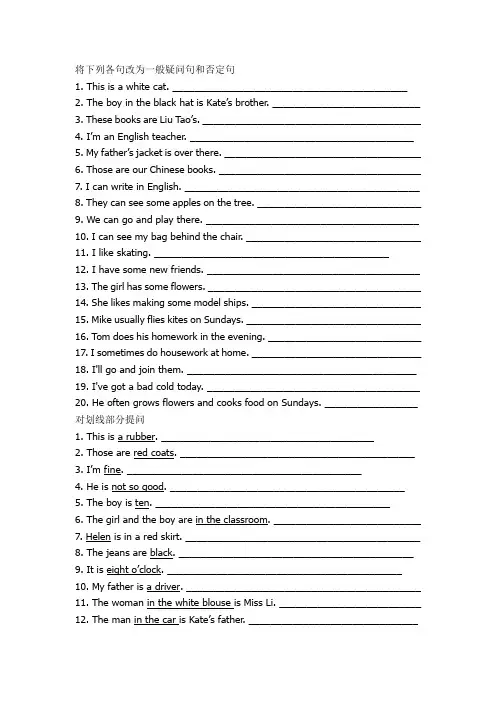
将下列各句改为一般疑问句和否定句1. This is a white cat. ___________________________________________2. The boy in the black hat is Kate’s brother. ___________________________3. These books are Liu Tao’s. ________________________________________4. I’m an English teacher. _________________________________________5. My father’s jacket is over there. ____________________________________6. Those are our Chinese books. _____________________________________7. I can write in English. ___________________________________________8. They can see some apples on the tree. ______________________________9. We can go and play there. _______________________________________10. I can see my bag behind the chair. ________________________________11. I like skating. ___________________________________________12. I have some new friends. _______________________________________13. The girl has some flowers. _______________________________________14. She likes making some model ships. _______________________________15. Mike usually flies kites on Sundays. ________________________________16. Tom does his homework in the evening. ____________________________17. I sometimes do housework at home. _______________________________18. I'll go and join them. __________________________________________19. I've got a bad cold today. _______________________________________20. He often grows flowers and cooks food on Sundays. _________________ 对划线部分提问1. This is a rubber. _______________________________________2. Those are red coats. ___________________________________________3. I’m fine. ___________________________________________4. He is not so good. ___________________________________________5. The boy is ten. ___________________________________________6. The girl and the boy are in the classroom. ___________________________7. Helen is in a red skirt. ___________________________________________8. The jeans are black. ___________________________________________9. It is eight o’clock. ___________________________________________10. My father is a driver. ___________________________________________11. The woman in the white blouse is Miss Li. __________________________12. The man in the car is Kate’s father. _______________________________13. Her sister is a student. __________________________________________14. This is my father’s car. __________________________________________15. There’s a knife in the box. _______________________________________16. There are ten books on the table. _________________________________17. The book and the pencil are ten yuan. _____________________________18. Jim and Tom are very hungry. ____________________________________19. We can make some model planes. ________________________________20. The boys and the girls like pandas. _______________________________21. I do my homework on Saturday afternoon. __________________________22. Wang Bing sometimes does housework at home. _____________________23. We like playing football very much_________________________________。
一般疑问句,否定句以及根据答句写问句的答题方法
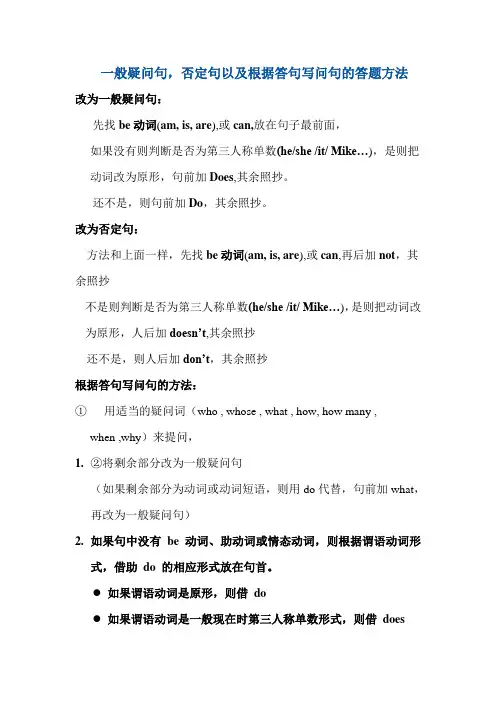
一般疑问句,否定句以及根据答句写问句的答题方法改为一般疑问句:先找be动词(am, is, are),或can,放在句子最前面,如果没有则判断是否为第三人称单数(he/she /it/ Mike…),是则把动词改为原形,句前加Does,其余照抄。
还不是,则句前加Do,其余照抄。
改为否定句:方法和上面一样,先找be动词(am, is, are),或can,再后加not,其余照抄不是则判断是否为第三人称单数(he/she /it/ Mike…),是则把动词改为原形,人后加doesn’t,其余照抄还不是,则人后加don’t,其余照抄根据答句写问句的方法:①用适当的疑问词(who , whose , what , how, how many ,when ,why)来提问,1.②将剩余部分改为一般疑问句(如果剩余部分为动词或动词短语,则用do代替,句前加what,再改为一般疑问句)2.如果句中没有be 动词、助动词或情态动词,则根据谓语动词形式,借助do 的相应形式放在句首。
●如果谓语动词是原形,则借do●如果谓语动词是一般现在时第三人称单数形式,则借does●如果陈述句中有实义动词have,且表示“有”时,借助动词do、does●e.g I have some friends in America. →Do you have any friends in America?需要注意的是:借does 或did 后,原句的谓语动词要变回原形。
e.g Bill gets up at 6:30 every day.→Does bill gets up at 6:30 every day?The students saw a film yesterday.→Did the students see a film yesterday?注意:陈述句变一般疑问句注意的事项:●如果陈述句中有第一人称,则变问句时要变为第二人称。
五年级否定句-一般疑问句-特殊疑问句讲解和练习
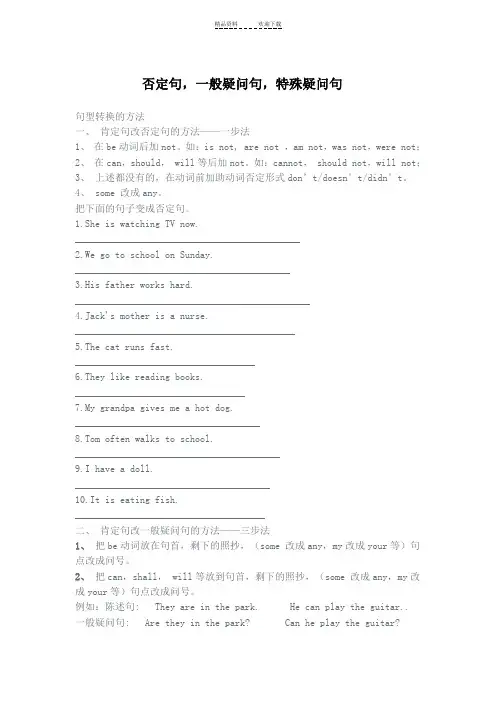
否定句,一般疑问句,特殊疑问句句型转换的方法一、肯定句改否定句的方法——一步法1、在be动词后加not。
如:is not, are not ,am not,was not,were not;2、在can,should, will等后加not。
如:cannot, should not,will not;3、上述都没有的,在动词前加助动词否定形式don’t/doesn’t/didn’t。
4、 some 改成any。
把下面的句子变成否定句。
1.She is watching TV now._____________________________________________2.We go to school on Sunday.___________________________________________3.His father works hard._______________________________________________4.Jack's mother is a nurse.____________________________________________5.The cat runs fast.____________________________________6.They like reading books.__________________________________7.My grandpa gives me a hot dog._____________________________________8.Tom often walks to school._________________________________________9.I have a doll._______________________________________10.It is eating fish.______________________________________二、肯定句改一般疑问句的方法——三步法1、把be动词放在句首,剩下的照抄,(some 改成any,my改成your等)句点改成问号。
把下列句子改成一般疑问句并作否定回答
把下列句子改成一般疑问句并作否定回答。
1、I was so happy.2、There were some flowers near the river.3、He will go cycling tomorrow.4、John does his homework after school.5、They play badminton on the weekend.6、We shall take a deep breath.7、Amy saw a film yesterday.8、My father read a book just now.9.Sarah is taking pictures .10.My brother goes to school on foot.把下列句子改成一般疑问句并作否定回答。
1、I was so happy.2、There were some flowers near the river.3、He will go cycling tomorrow.5、John does his homework after school.5、They play badminton on the weekend.6、We shall take a deep breath.9、Amy saw a film yesterday.10、My father read a book just now.9.Sarah is taking pictures .10.My brother goes to school on foot.把下列句子改成否定句。
1、I was so happy.2、There were some flowers near the river.3、He will go cycling tomorrow.6、John does his homework after school.5、They play badminton on the weekend.6、We shall take a deep breath.11、Amy saw a film yesterday.12、My father read a book just now.10.Sarah is taking pictures .10.My brother goes to school on foot.把下列句子改成否定句。
陈述句改为一般疑问句或否定句
一、陈述句改为一般疑问句:1.当句子中含有be动词(am is are was were)或情态动词(can,could,may,might,will,would,must,need,shall,should等)或在完成时态中(has/have/had+过去分词)时,把这些助动词提到句首。
如:①He is a docter.-----Is he a docter? ②They were in the house yesterday.----Were they in……?③Tom can swim.----Can Tom swim? ④He has been to the park.----Has he been to the park? 另外,为符合实际习惯I am/We are..…------Are you…? I was/We were…-----Were you….?I /We can…-----Can you…..? I /We have +过去分词…..------Have you…….?2.当句中含有实义动词时,也就是句子不含上面所提到那些助动词时,必须在句首加DO/Does/Did,具体情况分以下三方面:㈠当句子中含有动词原型时,在句子前加Do, 其中,I+动词。
------Do you…?如:①I like music.---Do you like music? ②They work here.----Do they work here?㈡当句子中含有的动词加S或ES时,即句子是一般现在时,且主语为第三人称单数时,在句子前加Does.如:①He likes music.------Does he like music?②Tom comes from China.-----Does Tom come from China?(注意在此情况下,应把疑问句中的动词变原型。
)㈢当句子中的动词为过去式,在句子前加Did再把动词变原型。
改一般疑问句及否定句
句型转换讲解与练习题(补差)
第一种情况:原句中有be(am/is/are)动词
1.改为一般疑问句的方法:把be动词移到句首,有I改为you, 有my改为your。
2. 改为否定句的方法:在am/is/are的后面加not。
第二种情况:原句中无be动词
1.改为一般疑问句的方法:
a. 主语非第三人称单数,在原句句首加Do,有I改为you, 有my改为your。
b. 主语是第三人称单数,在原句句首加Does, 同时,把原句中的动词单三式必须改为动
词原形。
2.改为否定句的方法:在原句的主语和动词之间加don’t;主语是第三人称单数加doesn’t,
同时,原句中是动词单三式的必须改为动词原形
把下列句子改为疑问句并作肯定和否定回答,以及改为否定句。
1. I am a student.
2. Tom is in Class One, Grade Seven.
3. Those are my friends.
4. I have a brother.
5. He has two basketballs
6. Mike likes bananas.。
变否定和一般疑问句
对划线部分提问1
1. What 1)对不是人的物和事提问。 2)对前面出现了name的人名提问。 3)对数字本身提问。 4)对表示职业的名词(a doctor, a teacher 等)提问。 2. What do…do ?对动词原形提问。 3. What does…do? 对动词三单现提问。 4. What did…do? 对动词过去式提问。 5. What …doing? 对动词现在分词(v.ing)提问。 6. What …be the weather like…?或How …be the weather?对表示天气状况 的adj(如 sunny, cloudy, windy, rainy, foggy, snowy等)提问。 7. What color 对做表语、宾语的颜色提问。 8. What day 对星期几,节日,生日提问。 9. What date 对几月几日提问。 10. What time 对做表语、状语的时间点(如6:30 at 7:00PM等)提问。 11.What class/row/grade/school等对诸如:Class Four, Row Three, Grade Seven, No. 8 Middle School 的短语提问。 12. Who 对表示人的名词提问。 13. Why 对because +句子(because从句)提问。
1. 变一般疑问句时,肯定句中有some,就把some变成any。 2. 变一般疑问句时,肯定句中有is,就把Is提到句首。 3. 变一般疑问句时,肯定句中有are,就把Are提到句首。 4. 变一般疑问句时,肯定句中有was,就把Was提到句首。 5. 变一般疑问句时,肯定句中有were,就把Were提到句首。 6. 变一般疑问句时,肯定句中有can,就把Can提到句首。 7. 变一般疑问句时,肯定句中有could,就把Could提到句首。 8. 变一般疑问句时,肯定句中有will,就把Will提到句首。 9. 变一般疑问句时,肯定句中有would,就把Would提到句首。 10. 变一般疑问句时,肯定句中有shall,就把Shall提到句首。 11. 变一般疑问句时,肯定句中有should,就把Should提到句首。 12. 变一般疑问句时,肯定句中有may,就把May提到句首。 13. 变一般疑问句时,肯定句中有must,就把Must提到句首。 14. 变一般疑问句时,肯定句中有had better,就把Had提到句首。 15.变一般疑问句时,肯定句中有used to ,就把Used提到句首;也可以在句首前面加Did, 而把used,变为 use。 16. 变一般疑问句时,肯定句中有肯定句中有实义动词原型,就在句首加Do。 17. 变一般疑问句时,肯定句中有实义动词三单现,就在句首加Does, 实义动词三单现变 回实义动词原型。 18. 变一般疑问句时,肯定句中有实义动词过去式,就在句首加Did, 实义动词过去式变回 实义动词原型。 19. 变一般疑问句时,肯定句是I am… ,就把I am…变成Are you….。 20. 变一般疑问句时,肯定句I was… ,就把I was…变成Were you…。
- 1、下载文档前请自行甄别文档内容的完整性,平台不提供额外的编辑、内容补充、找答案等附加服务。
- 2、"仅部分预览"的文档,不可在线预览部分如存在完整性等问题,可反馈申请退款(可完整预览的文档不适用该条件!)。
- 3、如文档侵犯您的权益,请联系客服反馈,我们会尽快为您处理(人工客服工作时间:9:00-18:30)。
句型转换讲解与练习题(补差)
第一种情况:原句中有be(am/is/are)动词
1.改为一般疑问句的方法:把be动词移到句首,有I改为you, 有my改为your。
2. 改为否定句的方法:在am/is/are的后面加not。
第二种情况:原句中无be动词
1.改为一般疑问句的方法:
a. 主语非第三人称单数,在原句句首加Do,有I改为you, 有my改为your。
b. 主语是第三人称单数,在原句句首加Does, 同时,把原句中的动词单三式必须改为动
词原形。
2.改为否定句的方法:在原句的主语和动词之间加don’t;主语是第三人称单数加doesn’t,
同时,原句中是动词单三式的必须改为动词原形
把下列句子改为疑问句并作肯定和否定回答,以及改为否定句。
1. I am a student.
2. Tom is in Class One, Grade Seven.
3. Those are my friends.
4. I have a brother.
5. He has two basketballs
6. Mike likes bananas.。
